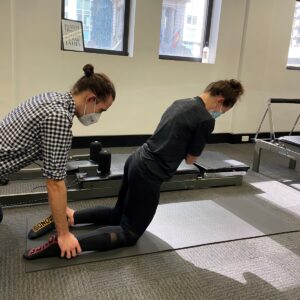Hamstring Injuries are unfortunately a common occurrence in running sports. Estimates of occurrence vary, but one study of competitive soccer players reported hamstring injury in 15% of players with a recurrence rate of 30%.1 Certainly not ideal statistics for competitors wanting to perform their best.
Running and cutting sports demand fast explosive speed and precision, therefore training and rehab need to prepare the body to match these forces particularly in the muscles most susceptible to injury.
Returning to sport is a multi-factorial process that includes nutrition, fitness, strength, working with trainers, coaches, and physios. One way Physiotherapists prepare athletes returning from injury is ensuring their rehab program replicates the forces of the sport. A soccer player needs to be able to sprint quickly and change directions so exercises like gentle hamstring stretches simply will not cut it. The term functional exercise is often used to describe exercises that replicates the function of the sport itself. For sports like soccer this would include exercise that eccentrically load the hamstring and include high speed and change of direction demands.
When we run, hamstrings are exposed to heavy eccentric loads. Studies show that peak hamstring activity occurs at the end of swing phase as our foot is about to strike the ground.2 Therefore the muscles need to have the strength, flexibility, and tissue composition to handle these forces. Rehab will be achieved through high load eccentric hamstring activity. This means exercises when the hamstrings need to lengthen under heavy load. A great example of an exercise that replicates this is the Nordic hamstring curl.
While Nordics do not “replicate” running as we do not kneel in the ground and fall forward during soccer (most of us anyway) but they do replicate the demand needed on the muscles. Nordics expose the hamstring to large eccentric loads which is why research finds them to be extremely useful in preventing injury.2
These exercises are harder than they look and can really highlight an area of weakness. I know the first time I tried it I was surprised at how fast my hamstring cramped and struggled to perform the exercise at all.
Try it at home with a friend. Warm up your hamstrings with some gentle bridge exercises and light jogging. Kneel on the floor with a towel under your knees. Have your friend hold you at the ankles with comfortable pressure. Cross your arms over your chest and start to slowly lean forward with control. See how far you can go before you start to drop to the floor. Put your hands out to catch and repeat this again. See if you can get close to the ground or cramp up before you lean beyond ninety degrees like myself!
References:
- Ekstrand, J., Waldén, M., & Hägglund, M. (2016). Hamstring injuries have increased by 4% annually in men’s professional football, since 2001: a 13-year longitudinal analysis of the UEFA Elite Club injury study. British journal of sports medicine, 50(12), 731-737.
- Chumanov, E. S., Wille, C. M., Michalski, M. P., & Heiderscheit, B. C. (2012). Changes in muscle activation patterns when running step rate is increased. Gait & posture, 36(2), 231-235.






